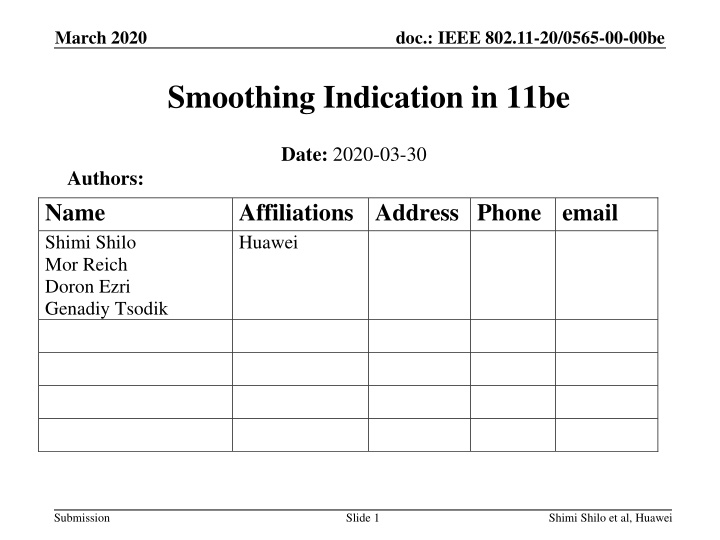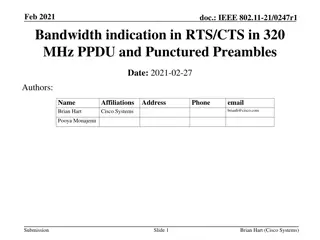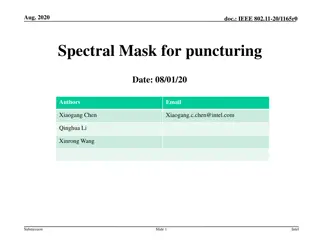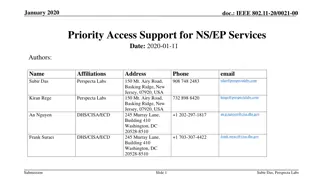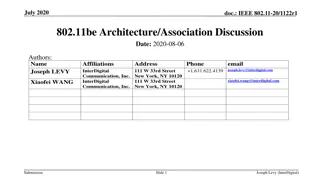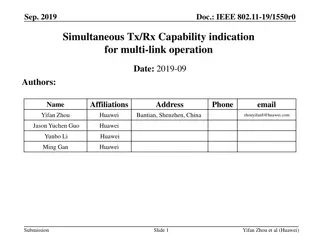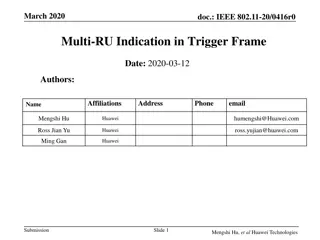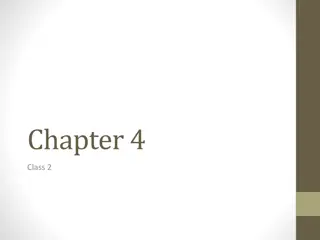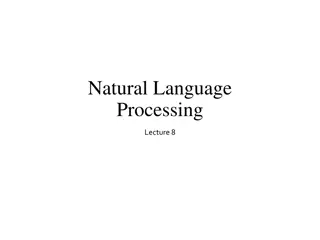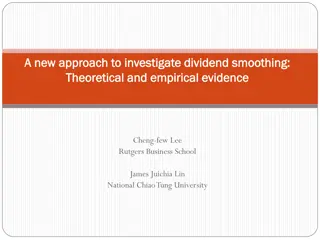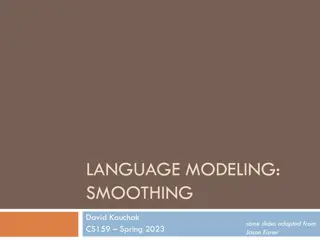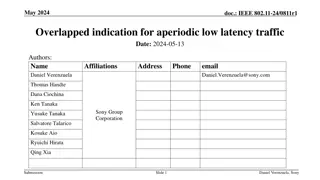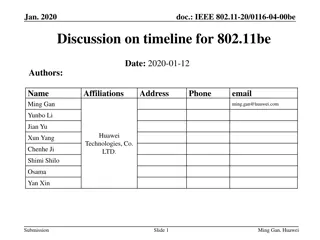IEEE 802.11-20/0565-00-00be: Smoothing Indication in 11be
This document discusses the methodology of indicating beamforming and smoothing recommendations in IEEE 802.11-20/0565-00-00be standard, focusing on the evolution from 11n to 11ax. It highlights the significance of post-BF channel smoothness, introduces recommendations for different scenarios including MU-MIMO, and explores the implications of beamformed bits in various PPDU types.
Download Presentation

Please find below an Image/Link to download the presentation.
The content on the website is provided AS IS for your information and personal use only. It may not be sold, licensed, or shared on other websites without obtaining consent from the author.If you encounter any issues during the download, it is possible that the publisher has removed the file from their server.
You are allowed to download the files provided on this website for personal or commercial use, subject to the condition that they are used lawfully. All files are the property of their respective owners.
The content on the website is provided AS IS for your information and personal use only. It may not be sold, licensed, or shared on other websites without obtaining consent from the author.
E N D
Presentation Transcript
March 2020 doc.: IEEE 802.11-20/0565-00-00be Smoothing Indication in 11be Date: 2020-03-30 Authors: Name Shimi Shilo Mor Reich Doron Ezri Genadiy Tsodik Affiliations Address Phone email Huawei Submission Slide 1 Shimi Shilo et al, Huawei
March 2020 doc.: IEEE 802.11-20/0565-00-00be Introduction Recent standard versions (11n/ac/ax) have different methods for the transmitter to indicate to the receiver if beamforming is used and recommend if smoothing CHEST should be used In particular, starting in 11ac (where DL MU-MIMO was introduced), there is no specific smoothing indication (especially in MU-MIMO) Various beamformer implementations may ensure smoothness of the post-BF channel, also in the MU-MIMO case Applying smoothing CHEST can yield several dB gain (e.g. 2.5dB, see [1]) In this contribution, we propose to indicate beamforming (or smoothing CHEST recommendation) for all cases, including MU-MIMO, in 11be Submission Slide 2 Shimi Shilo et al, Huawei
March 2020 doc.: IEEE 802.11-20/0565-00-00be Smoothing/Beamformed in 11n/11ac In 11n, there is a smoothing bit within HT-SIG indicating to the receiver if smoothing CHEST is recommended The criterion to determine if smoothing bit should be set to 1 (inferring that the post-BF channel is smooth) is defined as: In 11ac, there is a beamformed bit within VHT-SIG-A indicating if a beamforming steering matrix is applied for an SU PPDU; for an MU PPDU, it is always set to 1 If the beamformed bit is set to 1 , it is recommended not to apply smoothing CHEST at the receiver Submission Slide 3 Shimi Shilo et al, Huawei
March 2020 doc.: IEEE 802.11-20/0565-00-00be Beamforming Indication in 11ax In 11ax, the methodology is similar to 11ac: There is a beamformed bit within HE-SIG-A for an SU/ER PPDU There is a beamformed bit within the user field of a non-MU-MIMO HE- SIG-B field Hence, beamforming is indicated for an SU-MIMO case and implied for an MU-MIMO case Furthermore, the spec says the following: It is recommended that the spatial mapping matrix applied to HE-STF and beyond is chosen such that it pre-serves the smoothness of the physical channel, achieved by limiting the variation of each element s real and imaginary values in the spatial mapping matrix across successive tones within one RU. This is in line with the recommendation in [1] and [2] Submission Slide 4 Shimi Shilo et al, Huawei
March 2020 doc.: IEEE 802.11-20/0565-00-00be Problem Statement Both 11n and 11ac explicitly state that when beamforming is applied, the receiver should refrain from applying smoothing CHEST It is fair to assume that many STA (beamformee) designs relied on the smoothing / beamformed bit to determine whether to apply smoothing In 11ax, it is recommended (but not mandated) to maintain smoothness of the post-BF channel Furthermore, in 11ax (like 11ac) beamforming is (correctly) implicitly assumed in the case of MU-MIMO We assume some STAs will refrain from applying smoothing in these cases as well (both SU and MU-MIMO) Even when the transmitter (AP) maintains smoothness of the post-BF channel especially in the MU-MIMO case - some STAs will probably refrain from applying smoothing and hence their performance (and the performance of the entire system) will be degraded Submission Slide 5 Shimi Shilo et al, Huawei
March 2020 doc.: IEEE 802.11-20/0565-00-00be Solution In order to ensure a beamformee (typically a non-AP STA) applies smoothing CHEST to a beamformed transmission, whether it is SU or MU-MIMO, we propose one of the following: Replacing the beamformed bit with the smoothing bit, and indicating it for all PPDU types (both SU as well as MU-MIMO) Maintaining the beamformed bit (in case it is not being used by a receiver for additional purposes beyond smoothing) but indicating it for all PPDU types (including MU-MIMO) The transmitter can hence indicate beamformed = 0 even when the transmission is precoded, so receivers can apply smoothing In the MU-MIMO case, all parties know beamforming is used, so this bit can be used to indicate smoothing explicitly This will allow any STA to apply smoothing without having to analyze if the channel is smooth, maintaining simpler design at STA side This indication can be located within the U-SIG or EHT-SIG fields Submission Slide 6 Shimi Shilo et al, Huawei
March 2020 doc.: IEEE 802.11-20/0565-00-00be Smoothing Indication If the approach chosen is the re-introduction of the smoothing bit, then its the beamformer s (AP) responsibility to determine if the beamformee can apply smoothing What will be the criterion to set this field to 1 ? Similar to the recommendation in 11ax, the beamformer can determine that the post-BF channel is smooth In general a beamformer can choose any criterion, such as the 95% energy within the CP criterion from 11n It is important to note that in the MU-MIMO case, maintaining smoothness at the AP side doesn t incur much additional complexity Submission Slide 7 Shimi Shilo et al, Huawei
March 2020 doc.: IEEE 802.11-20/0565-00-00be Conclusions We presented the evolution of the beamformed / smoothing bit from 11n via 11ac to 11ax We discussed the potential problem of STAs not applying smoothing channel estimation on precoded allocations, including both SU-MIMO and MU-MIMO We then presented simple solutions to this problem, requiring no additional bits in the PHY preamble (at least for the SU-MIMO case) as well as unifying the approach for SU and MU-MIMO Submission Slide 8 Shimi Shilo et al, Huawei
March 2020 doc.: IEEE 802.11-20/0565-00-00be SP #1 Do you support indicating within the PHY preamble of 11be if smoothing can be applied at the receiver? This is for both SU-MIMO and MU-MIMO allocations - Yes - No - Abstain Submission Slide 9 Shimi Shilo et al, Huawei
March 2020 doc.: IEEE 802.11-20/0565-00-00be SP #2 Which of the following options do you support? - Option #1: Indicating beamformed bit also for MU-MIMO allocations - Option #2: Replacing beamformed bit with smoothing bit (and extending it to the MU-MIMO case) - Option #3: TBD (alternative solution) Submission Slide 10 Shimi Shilo et al, Huawei
March 2020 doc.: IEEE 802.11-20/0565-00-00be References 1. 11-16/1421: Smoothness Recommendation for HE-LTF 2. 11-16/0034: Beamforming with HE-LTF Compression Submission Slide 11 Shimi Shilo et al, Huawei
